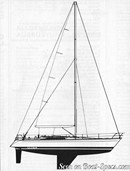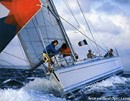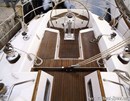First 456 S / Deep draft
Sailboat specifications
The First 456 is a 45’10” (13.95m) cruiser-racer sailboat designed by Frers Naval Architecture & Engineering (Argentina). She was built between 1982 and 1987 by Bénéteau (France). The S / Deep draft version offers a deeper keel, longer mast, and larger sail area.
The First 456 is as well listed, on Boat-Specs.com, in Deep draft and Shoal draft version (see all the versions compared).
The First 456 is as well listed, on Boat-Specs.com, in Deep draft and Shoal draft version (see all the versions compared).
First 456's main features
- Model
- First 456
- Version
- S / Deep draft
- Hull type
- Monohull
- Category
- Offshore cruiser-racer sailboat
- Sailboat builder
- Sailboat designer
- Sailboat range
- Country
- France
- Construction
- Hull and deck: GRP (glass reinforced polyester)
- First built hull
- 1982
- Last built hull
- 1987
- Appendages
- Keel : fin without bulb
- Helm
- Single helm wheel
- Rudder
- Single spade rudder
- Unsinkable
- No
- Trailerable
- No
- Former French navigation category
- 1
- Standard public price ex. VAT (indicative only)
- N/A €
First 456's main dimensions
- Overall length
- 46’ 7”14.2 m
- Hull length
- 45’ 10”13.95 m
- Waterline length
- 39’ 5”12 m
- Beam (width)
- 14’ 1”4.3 m
- Draft
- 7’ 11”2.4 m
- Light displacement (MLC)
- 26455 lb12000 kg
- Ballast weight
- 10362 lb4700 kg
First 456's rig and sails
- Upwind sail area
- 1362 ft²126.5 m²
- Downwind sail area
- 2266 ft²210.5 m²
- Mainsail area
- 490 ft²45.5 m²
- Genoa area
- 872 ft²81 m²
- Jib area
- 431 ft²40 m²
- Stormjib area
- 161 ft²15 m²
- Symmetric spinnaker area
- 1776 ft²165 m²
- Rigging type
- Sloop Marconi masthead
- Mast configuration
- Keel stepped mast
- Rotating spars
- No
- Number of levels of spreaders
- 2
- Spreaders angle
- 0 °
- Running backstays
- 1 set(s)
- Spars construction
- Aluminum spars
First 456's performances
- Upwind sail area to displacementiThe ratio sail area to displacement is obtained by dividing the sail area by the boat's displaced volume to the power two-thirds.
The ratio sail area to displacement can be used to compare the relative sail plan of different sailboats no matter what their size.
Upwind: under 18 the ratio indicates a cruise oriented sailboat with limited performances especially in light wind, while over 25 it indicates a fast sailboat. - 260 ft²/T24.13 m²/T
- Downwind sail area to displacementiThe ratio sail area to displacement is obtained by dividing the sail area by the boat's displaced volume to the power two-thirds.
The ratio sail area to displacement can be used to compare the relative sail plan of different sailboats no matter what their size. - 432 ft²/T40.16 m²/T
- Displacement-length ratio (DLR)iThe Displacement Length Ratio (DLR) is a figure that points out the boat's weight compared to its waterline length. The DLR is obtained by dividing the boat's displacement in tons by the cube of one one-hundredth of the waterline length (in feet).
The DLR can be used to compare the relative mass of different sailboats no matter what their length:
a DLR less than 180 is indicative of a really light sailboat (race boat made for planning), while a DLR greater than 300 is indicative of a heavy cruising sailboat. - 197
- Ballast ratioiThe Ballast ratio is an indicator of stability; it is obtained by dividing the boat's displacement by the mass of the ballast. Since the stability depends also of the hull shapes and the position of the center of gravity, only the boats with similar ballast arrangements and hull shapes should be compared.
The higher the ballast ratio is, the greater is the stability. - 39 %
- Critical hull speediAs a ship moves in the water, it creates standing waves that oppose its movement. This effect increases dramatically the resistance when the boat reaches a speed-length ratio (speed-length ratio is the ratio between the speed in knots and the square root of the waterline length in feet) of about 1.2 (corresponding to a Froude Number of 0.35) . This very sharp rise in resistance, between speed-length ratio of 1.2 to 1.5, is insurmountable for heavy sailboats and so becomes an apparent barrier. This leads to the concept of "hull speed".
The hull speed is obtained by multiplying the square root of the waterline length (in feet) by 1.34. - 8.41 knots
First 456's auxiliary engine
- Engine(s)
- 1 inboard engine
- Engine(s) power (min./max.)
- 55 HP / 80 HP
- Fuel type
- Diesel
- Fuel tank capacity
- 52.8 gal200 liters
First 456's accommodations and layout
- Cockpit
- Closed aft cockpit
- Cabin(s) (min./max.)
- 2 / 4
- Berth(s) (min./max.)
- 4 / 10
- Head(s) (min./max.)
- 2 / 3
- Freshwater tank capacity
- 105.7 gal400 liters
- Boiler capacity
- 11.1 gal42 liters










Bénéteau First 456 interior and accommodations - - 9/10
Picture extracted from the commercial documentation © Bénéteau
Picture extracted from the commercial documentation © Bénéteau


Bénéteau First 456 interior and accommodations - - 10/10
Picture extracted from the commercial documentation © Bénéteau
Picture extracted from the commercial documentation © Bénéteau
Similar sailboats that may interest you:
Sailboats
First built hull
Hull length
2004
43’ 10”13.35 m
2007
44’ 11”13.68 m
1990
45’ 7”13.9 m
1999
47’ 7”14.5 m
1988
52’ 6”16 m
1988
44’ 1”13.44 m
1993
49’14.93 m
1981
43’ 5”13.22 m
1981
41’ 11”12.77 m
1981
41’ 11”12.77 m
1986
50’15.23 m
2017
50’ 11”15.51 m
1984
44’13.4 m
1982
45’ 10”13.95 m
1978
44’ 5”13.54 m